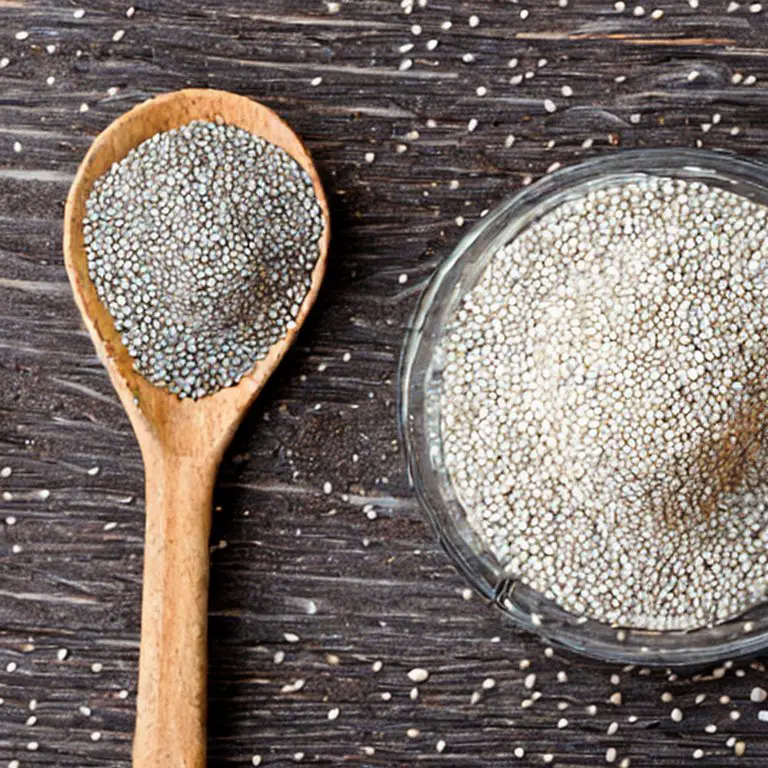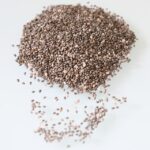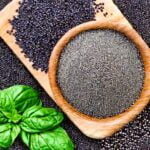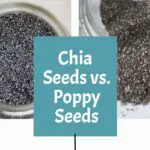Chia seeds are a popular superfood that are known for their high nutrient content and numerous health benefits. They are small, nutty-flavored seeds that come from the plant Salvia hispanica, which is native to Central and South America. Chia seeds are an excellent source of fiber, protein, and omega-3 fatty acids, and are a good source of various micronutrients such as calcium, phosphorus, and magnesium.
There are two main types of chia seeds: black chia seeds and white chia seeds. Both types of chia seeds come from the same plant and have similar nutrient profiles, but there are a few differences between the two.

In this post, we will explore the physical characteristics, nutrient content, and culinary uses of black and white chia seeds, and discuss the differences between the two types.
- What are Chia Seeds?
- White vs Black Chia Seeds
- Which is Better?
- Why are White Chia Seeds More Expensive?
- Common Questions
- Final Thoughts
What are Chia Seeds?
Chia seeds are small, nutty-flavored seeds that are packed with nutrients and offer a variety of health benefits. They come from the plant Salvia hispanica, which is native to Central and South America.
Chia seeds are an excellent source of fiber, protein, and omega-3 fatty acids, and are a good source of various micronutrients such as calcium, phosphorus, and magnesium. They can be easily incorporated into the diet by adding them to a variety of dishes, including smoothies, oatmeal, yogurt, and baked goods.
White vs Black Chia Seeds
There are two main types of chia seeds: black chia seeds and white chia seeds. Both types of chia seeds come from the same plant and have similar nutrient profiles, but there are a few differences between the two.
Color
One difference is the color. As the name suggests, black chia seeds are black in color, while white chia seeds are white or off-white in color. The color of the seeds is determined by the color of the outer layer, or seed coat, which is brown in black chia seeds and white in white chia seeds.

The color of the seed coat does not affect the nutrient content of the seeds.
Texture
Another difference is the texture. Black chia seeds have a slightly harder texture and may be slightly more crunchy when eaten. White chia seeds have a softer texture and may be slightly more mushy when eaten.
Nutrients
In terms of nutrient content, there is not much difference between black and white chia seeds. Both types of chia seeds are high in fiber, with about 10 grams of fiber per ounce (28 grams).
This can help support digestive health and prevent constipation. Both types of chia seeds are also high in omega-3 fatty acids, with about 17 grams of omega-3s per 100 grams of chia seeds. Omega-3s are important for brain health and have anti-inflammatory effects.
Both types of chia seeds are a good source of various micronutrients such as calcium, phosphorus, and magnesium. (You can learn more at Black Chia Seeds Benefits)
Taste
there is a slight difference in taste between the two types of chia seeds.
Black chia seeds have a slightly nuttier flavor than white chia seeds, which have a milder, slightly sweeter flavor. The flavor of chia seeds is generally subtle and may be masked by other ingredients in a recipe.
It’s worth noting that the flavor of chia seeds may also vary slightly depending on the brand and where the seeds are grown. Some brands may have a slightly stronger or more pronounced flavor than others.
Overall, the difference in taste between black and white chia seeds is relatively minor and may not be noticeable in most recipes. Both types of chia seeds can be easily incorporated into the diet and used in a variety of dishes. It ultimately comes down to personal preference and the specific recipe or dish in which the chia seeds will be used.
Culinary Use
In terms of culinary uses, both black and white chia seeds can be easily incorporated into the diet by adding them to a variety of dishes. They can be added to smoothies, oatmeal, yogurt, and baked goods for a boost of nutrients.
Chia seeds can also be used as a thickener in sauces and puddings, or as an egg replacement in vegan baking. They can be added to granola bars, energy balls, and other snacks for a crunchy texture and added nutrients.
Which is Better?
When it comes to choosing between black and white chia seeds, there is no clear advantage to one type over the other. Both black and white chia seeds are nutritious and can be easily incorporated into the diet as a plant-based source of omega-3s and other nutrients. It ultimately comes down to personal preference and the specific recipe or dish in which the chia seeds will be used.
For example, if you are making a dish that requires a subtle flavor and smooth texture, white chia seeds may be a better choice. They have a milder flavor and softer texture, which may be more suitable for dishes that require a delicate touch.
On the other hand, if you are making a dish that requires a crunchy texture or a more robust flavor, black chia seeds may be a better choice. They have a slightly nuttier flavor and crunchier texture, which may be more suitable for dishes that require a little more oomph.
Why are White Chia Seeds More Expensive?
White chia seeds may be more expensive than black chia seeds for a few reasons.
One reason is that white chia seeds are less common than black chia seeds. Black chia seeds are more widely available and are produced in larger quantities, which can make them less expensive. White chia seeds are produced in smaller quantities, which can make them more expensive.
Another reason is that white chia seeds may be considered a more premium product. They have a slightly milder flavor and softer texture than black chia seeds, which may be perceived as being more desirable by some consumers. This can make white chia seeds more expensive due to demand.
It’s worth noting that the price of chia seeds can also vary depending on the brand, where the seeds are grown, and other factors. Some brands may charge a higher price for their chia seeds due to the quality of the seeds or other factors.
Common Questions
White or Black Chia Seeds for Constipation?
Both black and white chia seeds are high in fiber and can be helpful for relieving constipation. Chia seeds are a good source of fiber, with about 10 grams of fiber per ounce (28 grams). This can help support digestive health and prevent constipation.
There is no significant difference between black and white chia seeds in terms of their fiber content or ability to relieve constipation. Both types of chia seeds can be easily incorporated into the diet to boost the fiber content and support digestive health.
White or Black Chia Seeds for Weight Loss?
Both black and white chia seeds may be helpful for weight loss due to their high fiber content and other nutrients. This can help promote feelings of fullness and reduce calorie intake, which can be helpful for weight loss.
In addition to their high fiber content, chia seeds are low in calories and high in protein, which can also help with weight loss. Protein can help reduce appetite and increase metabolism, and it is important for maintaining muscle mass during weight loss.
There is no significant difference between black and white chia seeds in terms of their fiber content, protein content, or calorie content. Both types of chia seeds can be easily incorporated into the diet to boost the fiber and protein content and support weight loss efforts.
White of Black Chia Seeds for Pudding?
Both black and white chia seeds can be used to make pudding, but the final texture and appearance of the pudding may be slightly different depending on the type of chia seeds used.
Black chia seeds have a slightly harder texture and may be slightly more crunchy when eaten. They may give the pudding a slightly crunchier texture and a speckled appearance due to the black seeds being visible in the pudding.
White chia seeds have a softer texture and may be slightly more mushy when eaten. They may give the pudding a smoother texture and a more uniform appearance, as the white seeds are less visible in the pudding.
Ultimately, the choice between black and white chia seeds for pudding will depend on personal preference and the desired texture of the pudding. Both types of chia seeds can be used to make pudding, and the final texture and appearance will depend on the specific recipe and the type of chia seeds used.
Black or White Chia Seeds for Overnight Oats?
Overnight oats may be made with both black and white chia seeds, and the final texture and appearance will depend on the recipe and the type of chia seeds used.
When consumed, black chia seeds have a somewhat firmer texture and may be significantly more crunchy. Because the black seeds are visible in the oats, they may give the oats a somewhat crunchier texture and a speckled look.
When consumed, white chia seeds have a softer feel and may be slightly mushy. Because the white seeds are less apparent in the oats, they may give the oats a smoother texture and a more uniform look.
Ultimately, the choice between black and white chia seeds for overnight oats will come down to personal preference and oat texture preference. Both varieties of chia seeds may be used to produce overnight oats, and the final texture and look will vary depending on the recipe and the chia seeds used.
Final Thoughts
In conclusion, both black and white chia seeds are nutritious and can be easily incorporated into the diet as a plant-based source of omega-3s and other nutrients. While there are a few differences between the two types of chia seeds in terms of color, texture, and possibly flavor, these differences are relatively minor and do not significantly impact the overall nutrient content of the seeds.
When it comes to choosing between black and white chia seeds, it ultimately comes down to personal preference and the specific recipe or dish in which the chia seeds will be used. Both types of chia seeds offer a wide range of potential health benefits and are worth considering as a nutritious addition to the diet.
Lance has been passionate about the plant-based diet and we have been following a whole food plant-based diet for over 5 years. We focus on health, natural healing, weight management, animal rights, and the health of the planet and environment by focusing on whole plant-based foods and sustainable practices.
Learn more at the About Me page and follow on social media at the links below.






